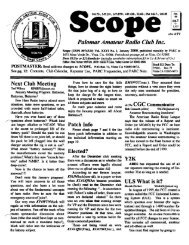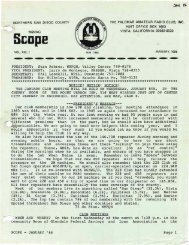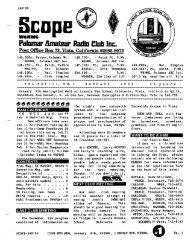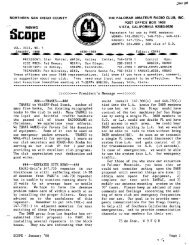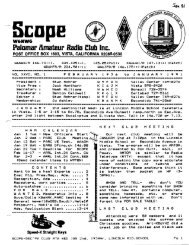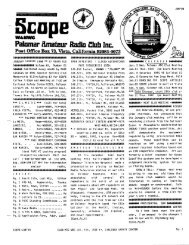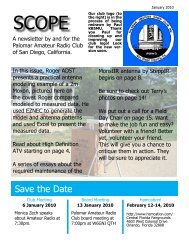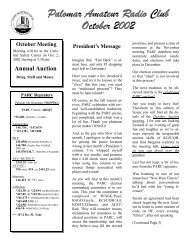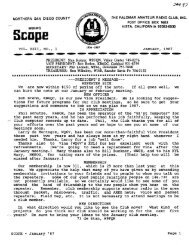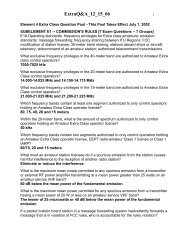Create successful ePaper yourself
Turn your PDF publications into a flip-book with our unique Google optimized e-Paper software.
»»»»»»»»»»»»PRESIDENT'S MESSAGE«««««««««««« <br />
###--- K0JPK/R AGAIN ---###<br />
(and again, and again)<br />
I monitor 146.730 many times when I am not<br />
able to get to a transmitter so I was not able to<br />
comment to several of our newer members on<br />
the probable cause of some of the QRM they<br />
were experiencing. KOJPK/R is located in Industrial<br />
Hills at the intersection of the 605 and 60<br />
freeways in southwest Covina and is also on<br />
146.730. Their use of the frequency has not been<br />
coordinated by TASMA because they refuse to<br />
adjust their antenna pattern to E-W and thus<br />
limit their intrusion into the San Diego area. It<br />
looks as if it is only the "good guys" who have to<br />
follow TASMA's directions. TASMA has no<br />
enforcement powers and the FCC is out back<br />
somewhere domg something imponant.<br />
SAMPLE PROBLEMS<br />
1) You hear talking on the channel after<br />
W6NWG/R drops out. You are probably hearing<br />
KOJPK/R 95% of the time.<br />
2) You hear a low frequency heterodyne (growl)<br />
during a transmission. It is probably KOJPK/R<br />
beating against W6NWG/R. It sometimes sounds<br />
like another PL tone on W6NWG/R.<br />
3) You hear two "kerchunks" at end of a transmission.<br />
The first one is W6NWG/R and the<br />
second is KOJPK/R although they are almost<br />
together.<br />
4) You hear what you think is W6NWG/R but<br />
not at its normal strength. It's probably<br />
KOJPK/R. You can tell by the distorted audio.<br />
5) You answer someone on 146.730 but for some<br />
reason they don't hear you and yet you know you<br />
are making our repeater. It's really KOJPK/R<br />
that you hear but can't key up.<br />
6) You hear "one sided" conversations with poor<br />
audio. KOJPK/R is being keyed up by someone<br />
working the Ventura or Lancaster machines<br />
(both on 146.730).<br />
JPK's transmitter coverage has been reponed<br />
to be much different from its receive coverage<br />
because of the reponed use of an omni transmitter<br />
antenna and remote receivers. This means that<br />
they probably "tailor" their receive covera~e but<br />
dump "RF garbage" all over Southern California<br />
when transmitting as reported by various amateurs<br />
in the SoCal area. We use the same antenna<br />
for our transmitter and receiver so if you can<br />
hear us, you can work us with 5-10 watts.<br />
You can eliminate listening to KOJPK/R all of<br />
the time by installing a PL decoder to decode the<br />
. W6NWG/R PL tone of 3A (127.32 Hz) which is on<br />
our repeater at all times. This way you will only<br />
hear W6NWG/R when it comes on the air but<br />
remember to turn the decoder off when you<br />
change frequency or the band will seem "dead".<br />
The decoder will not eliminate the heterodyne<br />
warble between the repeaters but it will prevent<br />
you from hearing KOJPK/R's bad audio when<br />
W6NWG/R is not on the air. You can talk to<br />
Ralph-K6HA V about how his PL works.<br />
I seldom hear KOJPK/R at my QTH when my<br />
beam is pointed at <strong>Palomar</strong> Mountain since the<br />
null of the beam is in the direction of JPK. I have<br />
the best of both worlds: a null on KOJPK/R and a<br />
peak on W6NWG/R all at the same time!<br />
I do hear KOJPK/R with my HT in the truck<br />
outside of my QTH but for some reason I can no<br />
longer key up KOJPK/R with the HT from the<br />
truck. We are required to supply T ASMA with<br />
complete system dIagrams of our repeater installation<br />
(done) and I assume that KOJPK/R still<br />
has not provided T ASMA with theirs. So<br />
TASMA probably does not know what type of<br />
transmitter, remote receivers, and antenna configuration<br />
KOJPK/R is using. There are sections<br />
of San Diego Co. where KOJPK can be keyed up<br />
easily with an HT at one watt into a "rubber<br />
duck". We really are fortunate that very few<br />
people use that repeater so it is not on the air<br />
much except when we key it up. At this QTH I<br />
hear only kerchunks, repeater CW ID, hetrodynes.<br />
and occasional users who sound quite<br />
dIstorted. There are W6NWG/R users in the San<br />
Diego area who key up KOJPK/R on almost<br />
every transmission without trying. I guess the<br />
KOJPK/R users don't mind these "one sided"<br />
conversations on their repeater since few people<br />
apparently listen to it anyway. Since their RF<br />
garbage has been reported to the North and<br />
South of them, we wonder what this non-club,<br />
seldom-used repeater, is doing for amateur radio.<br />
The moral IS: If you want to get rid of<br />
KOJPK/R you can 1) Install a PL decoder, 2) Buy<br />
a good beam or. 3) Shut off your radio. I fortunately<br />
have forgotten the 4th suggestion.<br />
Well, I hope that this will explain some of the<br />
"grunge" that you hear on 146.730 and also let<br />
you know that the "other" signal and the poor<br />
audio is not coming from us but from our friend<br />
up Nonh.<br />
###--- F LAS H ---###<br />
Fried Heyn, WA6WZO, our Southwest Division<br />
Director, called me this week and said that<br />
PARC placed third in the United States out of<br />
approximately 100 stations in the FIELD DA Y<br />
CONTEST this past summer in Category SA. It<br />
looks as if we were 1st in California with 8,574<br />
points. I can't wait to see the QST for November<br />
Scope - November '89 Page 3



